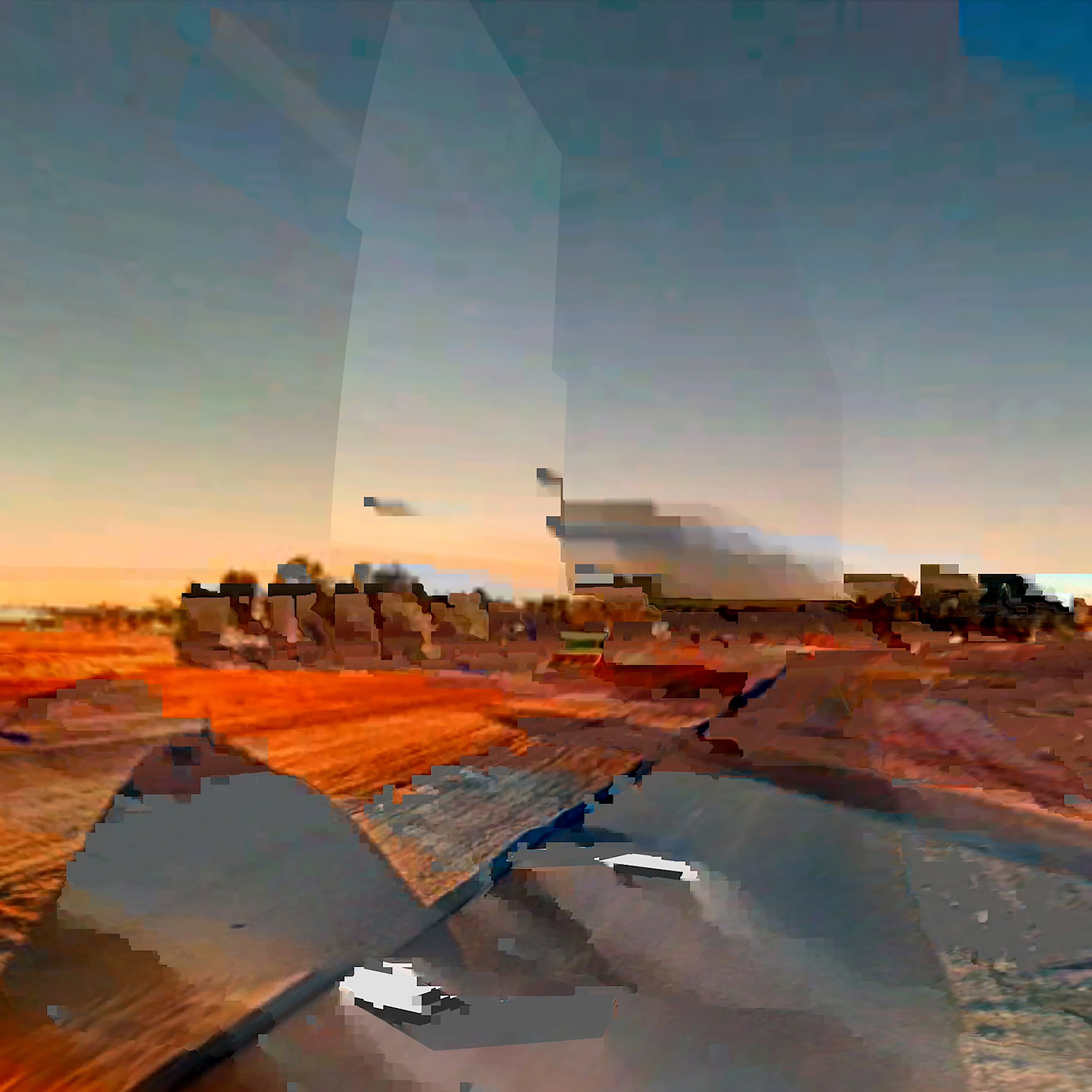Joseph L Griffiths,
Fountains for Moonee Ponds Creek

Jahkarli Romanis,
(Dis)connected to Country
Tributaries,
Silurian Geology
Amelia Hines,
Whoever’s is the Soil
Rhett Loban,
Torres Strait Virtual Reality
Addressing ecological crisis calls for a reimagining of the environment that foregrounds the more-than-human relations constituting everyday life. This argument is made not only by scholars, artists and activists but increasingly, and paradoxically, by the corporation and the colonising state. On stricken, unceded Wurundjeri Woi-wurrung land, ‘sustainable’ shopping centres unite nature and culture through ‘biophilic design’, while state-sponsored symposiums celebrate the promise of a ‘regenerative’ future—the cleansing sensibility of flow and circularity an attempt to smooth out the violent relations between ‘economy’ and ‘environment’. Meanwhile, First Nations displacement, toxic accumulation, and petro capitalism continue, showing us how the violent governance of ‘the environment’ is inherent to a colonial project that, despite embracing the aesthetic turn towards interconnectivity, continues to prioritise market forms of life over all others.1
How, then, might we engage the political and aesthetic possibilities of entanglement without rendering abstract the ongoing violence of colonial capitalism?2 The works in this exhibition by Jahkarli Romanis, Rhett Loban, Amelia Hine, Joseph L. Griffiths and Tributaries contribute to an archive of endurance addressing this question. In foregrounding ‘endurance’—a term we borrow from Elizabeth Povinelli—this exhibition traces how both colonial capitalism and its otherwises continue through space, both social and material3—the latter offering what Macarena Gómez-Barris describes as ‘realms of differently organised reality that are linked to, yet move outside of, colonial boundaries’.4 While sometimes evoking the etymology of ‘hardness’, the environments of endurance engaged in these works are divergent in their material, aesthetic and temporal infrastructures. Through different and multiple processes, including glitch aesthetics, virtual reality, sculptural gesture and collage, the works in enduring environments offer ways of visualising the contested spaces where the colonial project intersects with, yet never fully contains, its political otherwises.
One such otherwise is the complex relations of soil speculated on in Hine’s Whoever’s is the Soil, produced in collaboration with Hannah Reardon-Smith. The work visualises an underground lifeworld enduring despite the increasing presence of objects of extraction. Particular objects in Hine’s intricate video collage, such as the stalagmite, gesture towards a way of envisioning the future outside the temporal infrastructures of colonial capitalism; Tributaries' video silurian geology similarly employs collage to convey a more-than-human temporality where the smooth concrete lining of Moonee Ponds Creek meets an outcrop from the Silurian geologic period.
Where Hine’s and Tributaries’ works visualise the meeting points between ‘constraining’ and ‘surviving’ modes of endurance5, Loban’s Torres Strait Island Virtual Reality constructs a temporary, virtual world from the latter. The game engages Torres Strait Totems to unsettle the cartographical categories of land, sea and sky that, as Epeli Hau`Ofaf argues, connote the supposed ‘smallness and remoteness’6 of island life. Users are guided through night scenes by an abstract version of the constellation and Torres Strait Islander Totem, the shark Baidam, whose inhabitance of both ocean and sky connotes the vastness of Torres Strait Island worlds.
While Loban shows how the moving image might mediate First Nations stories, Romanis’ (Dis)connected to Country examines how documentation of the Australian landscape generated by Google Earth continues to obfuscate them. Locating moments when the viewpoint moves between ‘street view’ and ‘aerial view’, her aesthetic interference takes the form of a spatio-temporal glitch—‘an interruption within a transition, a troubled transmission’7. As First Nations’ connection to Country endures outside the colonial capitalist project, Romanis generates ways of seeing this endurance within the breakdown of the latter. Griffiths also engages with the political possibilities of infrastructural breakdown through a temporary remaking of the hydraulic environment in Fountains for Moonee Ponds Creek.
The environments of endurance examined in these works extend to their contested conditions of emergence, as Hine, Griffiths and Tributaries examine co-constitution with ongoing colonialism as both settlers and artists—through their practices and in our conversations. Meanwhile, for Loban, the endurance of deep culture within evolving information landscapes is reliant on the ‘Torres Strait Cultural Tree’8 that mediates Torres Strait knowledges and stories through new aesthetic assemblages. While Loban shows how modes of survival are always under construction, Romanis turns to the inherent instability of colonial infrastructures that, despite their endurance across the so-called Australian environment, cannot fully enclose their political otherwises.
Stitching together these works is a text response by Wergaia and Wemba Wemba writer Susie Anderson. Moving between the immediate and the contemplative, she frames the reader/viewer—and researcher and curator—as implicated in not only the colonising project but also in the process of encountering, or imagining, other possible worlds. While the latter might extend ‘an invitation to come inside’, Anderson reminds us ‘it was always only an invitation.’
- Elizabeth A. Povinelli, Economies of Abandonment : Social Belonging and Endurance in Late Liberalism (Durham N.C.: Duke University Press, 2011).
- Elizabeth A. Povinelli, Between Gaia and Ground : Four Axioms of Existence and the Ancestral Catastrophe of Late Liberalism (Durham: Duke University Press, 2021).
- Elizabeth A. Povinelli, Between Gaia and Ground : Four Axioms of Existence and the Ancestral Catastrophe of Late Liberalism (Durham: Duke University Press, 2021).
- Macarena Gómez-Barris, The Extractive Zone :Social Ecologies and Decolonial Perspectives (Durham: Duke University Press, 2017), 1.
- Elizabeth A. Povinelli, Between Gaia and Ground : Four Axioms of Existence and the Ancestral Catastrophe of Late Liberalism (Durham: Duke University Press, 2021), 137.
- Hau’ofa Epeli, “Our Sea of Islands,” The Contemporary Pacific 6, no. 1 (1994): 152.
- Lauren Berlant, On the Inconvenience of Other People (Durham: Duke University Press, 2022), 24.
- Rhett Loban, “Torres Strait Virtual Reality: A Reflection on the Intersection between Culture, Game Design and Research,” Games and Culture 17, no. 3 (2022): 311–27, https://doi.org/10.1177/15554120211020383.